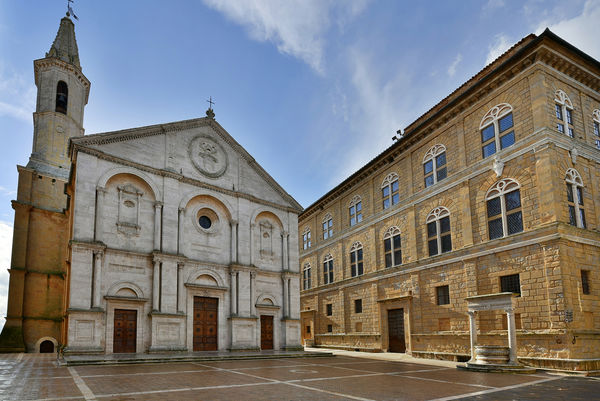Tuscany for Beginners
To experience Italy's rustic-yet-elegant essence, head for the hills.
By Rick Steves

Wedged between Florence and Rome, rural Tuscany offers the quintessential Italian experience: sun-soaked hill towns, green and rolling screen-saver hills, romantically fortified farms, and cypress trees marching single file up lonely ridges. We go to Italy to experience the finesse of Florence, the splish-splash of Venice, and the grandeur of Rome, but it's in Tuscany that we find the rustic-yet-elegant essence of Italia.
Built on hilltops for defensive purposes in ancient and medieval times, the lofty perches of Tuscany's hill towns today seem to protect them only from the modern world. After the hustle and bustle of urban Italy, it can be a joy to downshift to a more peaceful pace. With a surprising diversity of scenic lanes, abbeys, and wineries, the Tuscan countryside is a fine place to abandon your itinerary and just slow down.
This is one part of Italy where I recommend traveling by car. Although driving in Italy isn't for the faint of heart, in Tuscany it's a joy on super-scenic small roads — and the best way to lace together the views, villages, and vineyards. Trains link some villages, but stations are likely to be in a valley a few miles from the town center. Even buses can't make it up, up, up into some hill towns — some of the steepest villages have escalators serving car parks at the base of their cliffs.
Ideally, stay at an agriturismo or two. These farm-based guesthouses provide a good home base from which to experience the magic of the region. Some agriturismi are simple and rustic; others are downright fancy — but all are hosted by wonderful people eager to share their bit of paradise. And since many agriturismi are dedicated to making sure that their guests are as well fed as their cows, you may well be invited to enjoy a locally sourced meal that's truly indimenticabile (my new favorite Italian word…meaning "unforgettable").
Of course, a big reason for visiting Tuscany is to sample the great local wines. The region is dotted with classy wineries elegantly tucked into the hills, and many growers welcome visitors to their vineyards.
But unlike in the US, in Tuscany you usually need to book a tasting tour beforehand (a simple phone call a day or two ahead is usually sufficient). Most tours last an hour, cost about $10, and finish in tasting rooms where, with expert guidance, you'll develop a better appreciation of the fruit of the vines. The by-product: You slowly build up a trunkful of new favorite wines.
The biggest dilemma facing a first-timer in Tuscany is how in Dante's name to choose from the many hill towns vying for your attention. Each has its own appeal, and many are worthy of an overnight. To get my take, check out the "At a Glance" section of my Explore Tuscany page as well as my recommended itinerary for Tuscany.
While most hill towns are undeniably touristy, in the evening they become the domain of locals, who polish the cobbled streets with convivial promenades. Join in, and imagine the countless peasant backs that bent so many centuries ago to set these ancient, weathered stones into simple perfection.

